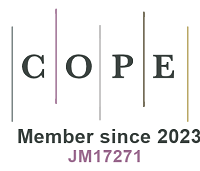REFERENCES
1. Castro MF, Almeida CA, Bazán C, Vidal J, Delfini CD, Villegas LB. Impact of anthropogenic activities on an urban river through a comprehensive analysis of water and sediments. Environ Sci Pollut Res Int. 2021;28:37754-67.
2. Akhtar N, Syakir Ishak MI, Bhawani SA, Umar K. Various natural and anthropogenic factors responsible for water quality degradation: a review. Water. 2021;13:2660.
3. Chen SS, Kimirei IA, Yu C, Shen Q, Gao Q. Assessment of urban river water pollution with urbanization in East Africa. Environ Sci Pollut Res Int. 2022;29:40812-25.
4. Capparelli MV, Moulatlet GM, de Souza Abessa DM, et al. An integrative approach to identify the impacts of multiple metal contamination sources on the Eastern Andean foothills of the Ecuadorian Amazonia. Sci Total Environ. 2020;709:136088.
5. Boula A, Laporte-magoni C, Gunkel-grillon P, Bour O, Selmaoui-folcher N. Potential contamination of stream waters by ultramafic mining sediments: Identification of geochemical makers (New Caledonia). J Geochem Explor. 2022;232:106879.
6. Corredor JA, Pérez EH, Figueroa R, Casas AF. Water quality of streams associated with artisanal gold mining; Suárez, Department of Cauca, Colombia. Heliyon. 2021;7:e07047.
7. Zendehbad M, Cepuder P, Loiskandl W, Stumpp C. Source identification of nitrate contamination in the urban aquifer of Mashhad, Iran. J Hydrol Reg Stud. 2019;25:100618.
8. Shi P, Zhang Y, Song J, et al. Response of nitrogen pollution in surface water to land use and social-economic factors in the Weihe River watershed, northwest China. Sustain Cities Soc. 2019;50:101658.
9. Negi P, Mor S, Ravindra K. Impact of landfill leachate on the groundwater quality in three cities of North India and health risk assessment. Environ Dev Sustain. 2020;22:1455-74.
10. Morera-Gómez Y, Alonso-Hernández CM, Santamaría JM, Elustondo D, Lasheras E, Widory D. Levels, spatial distribution, risk assessment, and sources of environmental contamination vectored by road dust in Cienfuegos (Cuba) revealed by chemical and C and N stable isotope compositions. Environ Sci Pollut Res Int. 2020;27:2184-96.
11. Kniggendorf AK, Wetzel C, Roth B. Microplastics detection in streaming tap water with Raman Spectroscopy. Sensors. 2019;19:1839.
12. Sun J, Dai X, Wang Q, van Loosdrecht MCM, Ni BJ. Microplastics in wastewater treatment plants: detection, occurrence and removal. Water Res. 2019;152:21-37.
13. Lv L, Yan X, Feng L, et al. Challenge for the detection of microplastics in the environment. Water Environ Res. 2021;93:5-15.
14. Dey TK, Uddin ME, Jamal M. Detection and removal of microplastics in wastewater: evolution and impact. Environ Sci Pollut Res Int. 2021;28:16925-47.
15. Sridhar A, Kannan D, Kapoor A, Prabhakar S. Extraction and detection methods of microplastics in food and marine systems: a critical review. Chemosphere. 2022;286:131653.
16. Couto CF, Lange LC, Amaral MC. Occurrence, fate and removal of pharmaceutically active compounds (PhACs) in water and wastewater treatment plants - a review. J Water Process Eng. 2019;32:100927.
17. Schulze S, Zahn D, Montes R, et al. Occurrence of emerging persistent and mobile organic contaminants in European water samples. Water Res. 2019;153:80-90.
18. Helmecke M, Fries E, Schulte C. Regulating water reuse for agricultural irrigation: risks related to organic micro-contaminants. Environ Sci Eur. 2020;32:4.
19. Huang C, Jin B, Han M, Yu Y, Zhang G, Arp HPH. The distribution of persistent, mobile and toxic (PMT) pharmaceuticals and personal care products monitored across Chinese water resources. J Hazard Mater Lett. 2021;2:100026.
20. Titchou FE, Zazou H, Afanga H, El Gaayda J, Akbour RA, Hamdani M. Removal of Persistent Organic Pollutants (POPs) from water and wastewater by adsorption and electrocoagulation process. Groundw Sustain Dev. 2021;13:100575.
21. Sikorski MJ, Levine MM. Reviving the “Moore Swab”: a classic environmental surveillance tool involving filtration of flowing surface water and sewage water to recover typhoidal salmonella bacteria. Appl Environ Microbiol. 2020;86:e00060-20.
22. La Rosa G, Bonadonna L, Lucentini L, Kenmoe S, Suffredini E. Coronavirus in water environments: occurrence, persistence and concentration methods - a scoping review. Water Res. 2020;179:115899.
23. Mohapatra S, Menon NG, Mohapatra G, et al. The novel SARS-CoV-2 pandemic: possible environmental transmission, detection, persistence and fate during wastewater and water treatment. Sci Total Environ. 2021;765:142746.
24. Sánchez Moreno H, Bolívar-Anillo HJ, Soto-Varela ZE, et al. Microbiological water quality and sources of contamination along the coast of the department of Atlántico (Caribbean Sea of Colombia). Preliminary results. Mar Pollut Bull. 2019;142:303-8.
25. Wan L, Wang H. Control of urban river water pollution is studied based on SMS. Environ Technol Innovation. 2021;22:101468.
26. Peña-Guzmán C, Ulloa-Sánchez S, Mora K, et al. Emerging pollutants in the urban water cycle in Latin America: a review of the current literature. J Environ Manage. 2019;237:408-23.
27. Gonsioroski A, Mourikes VE, Flaws JA. Endocrine disruptors in water and their effects on the reproductive system. Int J Mol Sci. 2020;21:1929.
28. Fernandes JP, Almeida CMR, Salgado MA, Carvalho MF, Mucha AP. Pharmaceutical compounds in aquatic environments-occurrence, fate and bioremediation prospective. Toxics. 2021;9:257.
29. Dharmaraj S, Ashokkumar V, Hariharan S, et al. The COVID-19 pandemic face mask waste: a blooming threat to the marine environment. Chemosphere. 2021;272:129601.
30. Chaturvedi P, Shukla P, Giri BS, et al. Prevalence and hazardous impact of pharmaceutical and personal care products and antibiotics in environment: a review on emerging contaminants. Environ Res. 2021;194:110664.
31. Wang X, Jain A, Chen B, et al. Differential efficacy of water lily cultivars in phytoremediation of eutrophic water contaminated with phosphorus and nitrogen. Plant Physiol Biochem. 2022;171:139-46.
32. Yu S, Miao C, Song H, Huang Y, Chen W, He X. Efficiency of nitrogen and phosphorus removal by six macrophytes from eutrophic water. Int J Phytoremediation. 2019;21:643-51.
33. Li T, Chu C, Zhang Y, Ju M, Wang Y. Contrasting eutrophication risks and countermeasures in different water bodies: assessments to support targeted watershed management. Int J Environ Res Public Health. 2017;14:695.
34. Lorenzo M, Picó Y. Wastewater-based epidemiology: current status and future prospects. Curr Opin Environ Sci Health. 2019;9:77-84.
35. Beyer S, Szewzyk R, Gnirss R, Johne R, Selinka HC. Detection and characterization of Hepatitis E virus genotype 3 in wastewater and urban surface waters in germany. Food Environ Virol. 2020;12:137-47.
36. Guo Y, Li J, O’Brien J, Sivakumar M, Jiang G. Back-estimation of norovirus infections through wastewater-based epidemiology: a systematic review and parameter sensitivity. Water Res. 2022;219:118610.
37. Janahi EM, Mustafa S, Parkar SFD, Naser HA, Eisa ZM. Detection of enteric viruses and bacterial indicators in a sewage treatment center and shallow water bay. Int J Environ Res Public Health. 2020;17:6483.
38. Sangkham S. A review on detection of SARS-CoV-2 RNA in wastewater in light of the current knowledge of treatment process for removal of viral fragments. J Environ Manage. 2021;299:113563.
39. Sosa-hernández JE, Oyervides-muñoz MA, Melchor-martínez EM, et al. Extensive wastewater-based epidemiology as a resourceful tool for SARS-CoV-2 surveillance in a low-to-middle-income country through a successful collaborative quest: WBE, mobility, and clinical tests. Water. 2022;14:1842.
40. Mahlknecht J, Padilla Reyes DA, Ramos E, Reyes LM, Álvarez MM. The presence of SARS-CoV-2 RNA in different freshwater environments in urban settings determined by RT-qPCR: implications for water safety. Sci Total Environ. 2021;784:147183.
41. Alvareda E, Lucas C, Paradiso M, et al. Water quality evaluation of two urban streams in Northwest Uruguay: are national regulations for urban stream quality sufficient? Environ Monit Assess. 2020;192:661.
42. Conecta. Arroyo Vivo, hacia una remediación ambiental en ríos y Arroyos de NL. Available from: https://conecta.tec.mx/es/noticias/monterrey/educacion/arroyo-vivo-hacia-una-remediacion-ambiental-en-rios-y-arroyos-de-nl. [Last accessed on 28 Jul 2023].
43. Secretaría de Comercio y Fomento Industrial. (2019). Aguas residuales.- Muestreo (PROY-NMX-AA-003-SCFI-2019). Diario Oficial de la Federación. Available from: https://www.dof.gob.mx/nota_detalle.php?codigo=5576620&fecha=25/10/2019#gsc.tab=0. [Last accessed on 28 Jul 2023].
44. Sapula SA, Whittall JJ, Pandopulos AJ, Gerber C, Venter H. An optimized and robust PEG precipitation method for detection of SARS-CoV-2 in wastewater. Sci Total Environ. 2021;785:147270.
45. American Public Health Association. Standard methods for the examination of water and wastewater (24th edition). Available from: https://secure.apha.org/imis/ItemDetail?iProductCode=978-087553-2998&CATEGORY=BK. [Last accessed on 28 Jul 2023].
46. Secretaría de Salud. Salud ambiental, Agua para uso y consumo humano Límites permisibles de calidad y tratamientos a que debe someterse el agua para su potabilización. (NOM-127-SSA1-1994). Diario Oficial de la Federación. Available from: http://www.salud.gob.mx/unidades/cdi/nom/127ssa14.html#:~:text=Esta%20Norma%20Oficial%20Mexicana%20establece,en%20todo%20el%20territorio%20nacional. [Last accessed on 28 Jul 2023].
47. Secretaría de Medio Ambiente y Recursos Naturales. (2022). Que establece los límites permisibles de contaminantes en las descargas de aguas residuales en cuerpos receptores propiedad de la nación (NOM-001-SEMARNAT-2021). Diario Oficial de la Federación. Available from: https://www.dof.gob.mx/nota_detalle.php?codigo=5645374&fecha=11/03/2022#gsc.tab=0. [Last accessed on 28 Jul 2023].
48. Mora A, García-Gamboa M, Sánchez-Luna MS, Gloria-García L, Cervantes-Avilés P, Mahlknecht J. A review of the current environmental status and human health implications of one of the most polluted rivers of Mexico: the Atoyac River, Puebla. Sci Total Environ. 2021;782:146788.
49. Patrick WH, Reddy KR. Nitrification-denitrification reactions in flooded soils and water bottoms: dependence on oxygen supply and ammonium diffusion. J environ qual. 1976;5:469-72.
50. Ulloa MJ, Álvarez-torres P, Horak-romo KP, Ortega-izaguirre R. Harmful algal blooms and eutrophication along the mexican coast of the Gulf of Mexico large marine ecosystem. Environ Dev. 2017;22:120-8.
51. Crisóstomo-Vázquez L, Alcocer-Morales C, Lozano-Ramírez C, Rodríguez-Palacio MC. Fitoplancton de la Laguna del Carpintero, Tampico, Tamaulipas, México. Interciencia 2016;41:103-9. Available from: https://dialnet.unirioja.es/servlet/articulo?codigo=5352219. [Last accessed on 28 Jul 2023].
52. Davidson K, Gowen RJ, Harrison PJ, Fleming LE, Hoagland P, Moschonas G. Anthropogenic nutrients and harmful algae in coastal waters. J Environ Manage. 2014;146:206-16.
53. Ahmed W, Payyappat S, Cassidy M, Harrison N, Besley C. Sewage-associated marker genes illustrate the impact of wet weather overflows and dry weather leakage in urban estuarine waters of Sydney, Australia. Sci Total Environ. 2020;705:135390.
54. Reynolds JH, Barrett MH. A review of the effects of sewer leakage on groundwater quality. Water Environ J. 2003;17:34-9.
55. Tran HN, Le GT, Nguyen DT, et al. SARS-CoV-2 coronavirus in water and wastewater: a critical review about presence and concern. Environ Res. 2021;193:110265.
56. Rimoldi SG, Stefani F, Gigantiello A, et al. Presence and infectivity of SARS-CoV-2 virus in wastewaters and rivers. Sci Total Environ. 2020;744:140911.
57. Giacobbo A, Rodrigues MAS, Ferreira JZ, Bernardes AM, de Pinho MN. A critical review on SARS-CoV-2 infectivity in water and wastewater. What do we know? Sci Total Environ. 2021;774:145721.
58. Azzi L, Carcano G, Gianfagna F, et al. Saliva is a reliable tool to detect SARS-CoV-2. J Infect. 2020;81:e45-50.
59. Mohammadi A, Esmaeilzadeh E, Li Y, Bosch RJ, Li JZ. SARS-CoV-2 detection in different respiratory sites: a systematic review and meta-analysis. EBioMedicine. 2020;59:102903.
60. Huang N, Pérez P, Kato T, et al. SARS-CoV-2 infection of the oral cavity and saliva. Nat Med. 2021;27:892-903.
61. Guerrero-Latorre L, Ballesteros I, Villacrés-Granda I, Granda MG, Freire-Paspuel B, Ríos-Touma B. SARS-CoV-2 in river water: implications in low sanitation countries. Sci Total Environ. 2020;743:140832.







